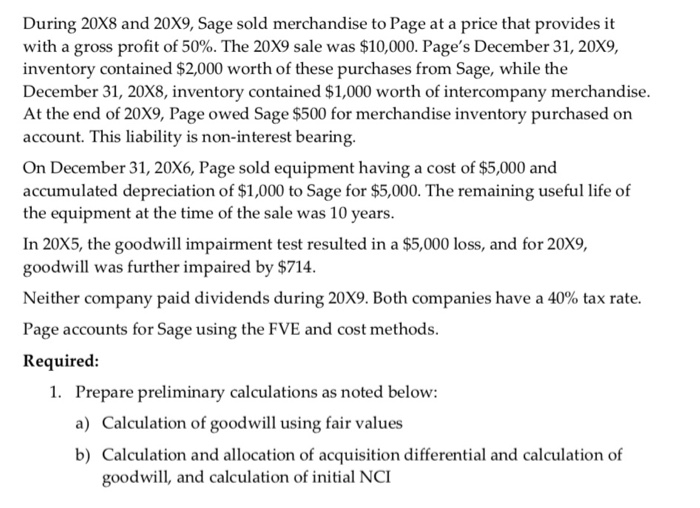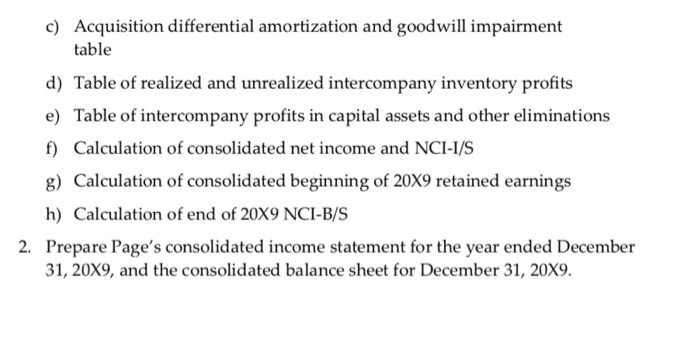Answered step by step
Verified Expert Solution
Question
1 Approved Answer
? On January 1, 20X2, Page Company acquired 70% of the outstanding common shares of Sage Ltd. for $45,500 in cash. On that date, Sage





 ?
?
On January 1, 20X2, Page Company acquired 70% of the outstanding common shares of Sage Ltd. for $45,500 in cash. On that date, Sage had $20,000 in common shares outstanding and $20,000 in retained earnings. At the time of the acquisition, the book value of each of Sage's assets was equal to its fair value except for the following: Inventory Buildings and equipment Accumulated depreciation Book value $20,000 $60,000 ($10,000) Fair value $25,000 $60,000 The buildings and equipment had a remaining useful life of 10 years at January 1, 20X2, and the inventory on hand at the time of the purchase was sold in 20X2. Any excess paid over the fair value was for Sage's good reputation in the herb industry, which Page set up as goodwill. Following are the financial statements for Page and Sage at December 31, 20X9. Assets Cash Separate Entity Balance Sheets at December 31, 20X9 Accounts receivable (net) Inventory Investment in Sage (cost method) Buildings and equipment Accumulated depreciation PAGE $ 29,500 60,000 45,000 45,500 90,000 (20,000) $ 250,000 SAGE $ 10,000 20,000 30,000 100,000 (50,000) $ 110,000 Liabilities Current liabilities Deferred income taxes Shareholders' equity Ordinary shares Retained earnings $ 40,000 10,000 $ 50,000 $ 70,000 130,000 200,000 $ 250,000 $ 25,000 5,000 $ 30,000 $ 20,000 60,000 80,000 $ 110,000 Sales Cost of goods sold Statements of Income and Retained Earnings for the year ended December 31, 20X9 Depreciation expense Other expenses Income tax expense Net income Retained earnings - Beginning Retained earnings - Ending PANSY $ 650,000 (300,000) 350,000 14,000 231,000 42,000 287,000 63,000 67,000 $ 130,000 SAGE $225,000 (112,500) 112,500 12,000 75,500 10,000 97,500 15,000 45,000 $ 60,000 During 20X8 and 20X9, Sage sold merchandise to Page at a price that provides it with a gross profit of 50%. The 20X9 sale was $10,000. Page's December 31, 20X9, inventory contained $2,000 worth of these purchases from Sage, while the December 31, 20X8, inventory contained $1,000 worth of intercompany merchandise. At the end of 20X9, Page owed Sage $500 for merchandise inventory purchased on account. This liability is non-interest bearing. On December 31, 20X6, Page sold equipment having a cost of $5,000 and accumulated depreciation of $1,000 to Sage for $5,000. The remaining useful life of the equipment at the time of the sale was 10 years. In 20X5, the goodwill impairment test resulted in a $5,000 loss, and for 20X9, goodwill was further impaired by $714. Neither company paid dividends during 20X9. Both companies have a 40% tax rate. Page accounts for Sage using the FVE and cost methods. Required: 1. Prepare preliminary calculations as noted below: a) Calculation of goodwill using fair values b) Calculation and allocation of acquisition differential and calculation of goodwill, and calculation of initial NCI c) Acquisition differential amortization and goodwill impairment table d) Table of realized and unrealized intercompany inventory profits e) Table of intercompany profits in capital assets and other eliminations f) Calculation of consolidated net income and NCI-I/S g) Calculation of consolidated beginning of 20X9 retained earnings h) Calculation of end of 20X9 NCI-B/S 2. Prepare Page's consolidated income statement for the year ended December 31, 20X9, and the consolidated balance sheet for December 31, 20X9.
Step by Step Solution
★★★★★
3.41 Rating (160 Votes )
There are 3 Steps involved in it
Step: 1
Consolidated statements Calculation of consolidated retained earnings ...
Get Instant Access to Expert-Tailored Solutions
See step-by-step solutions with expert insights and AI powered tools for academic success
Step: 2

Step: 3

Ace Your Homework with AI
Get the answers you need in no time with our AI-driven, step-by-step assistance
Get Started


